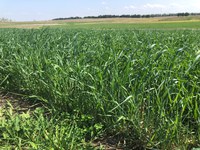Harvest window for quality winter rye forage is small
(Click the image below to view a high-resolution image that can be downloaded)
As the days get longer, grass growth is fast in the Northern Plains. Among the cereal grains, winter rye has one of the fastest growth rates, quickly moving from the vegetative stage to stem elongation and head emergence in the blink of an eye. This impressive rate of growth rate makes winter rye difficult to manage if the goal is to harvest for high-quality forage, says James Rogers, North Dakota State University Extension forage crops production specialist.
According to Rogers, there are three major factors that affect plant forage quality: plant species, plant part (leaves vs. stems) and plant maturity. Within a single plant species, plant maturity is the most important factor influencing forage nutrient content. All forage plants will go from a leafy, vegetative stage that is high in protein and low in fiber (high quality) to a reproductive stage that is low in protein and high in fiber (low quality). As the plant moves from vegetative high quality to reproductive low quality, plant yield increases. The rate at which plants progress from the vegetative stage to reproductive stage depends on species, with some plants, such as legumes, declining in quality at a much slower rate than a grass.
“Unfortunately, rye declines rapidly in quality with increasing maturity,” Rogers says. “This means that if you wish to capture rye at good forage quality to avoid it being ‘just a grinding hay,’ pay careful attention to plant maturity.”
Research conducted at University of Minnesota and Iowa State University shows that as rye maturity increases from vegetative to reproductive, there is a linear decline in crude protein and digestibility (energy). With declines in protein and energy, fiber content increases. Increased fiber will decrease ruminant daily voluntary dry matter intake. Limited intake, also limits protein and energy intake, which can then cause the ruminant animal to fall short of meeting daily nutritional requirements. If not corrected, this can lead to many negative ripple effects on production, Rogers warns.
“Forage yield increases with maturity, which is not a bad thing,” Rogers says. “We need yield to support herd size and to reduce and spread-out the cost of production, so there needs to be a compromise between forage yield and quality.”
For rye, the yield-quality compromise point for harvest is the boot stage. Boot stage is when the seed head has risen to the top of the stem at the base of the flag leaf. At this point, the seed head is easy to feel at the top of the stem but has not yet emerged.
“The problem with rye is that the boot stage lasts for only a very short period of time,” Rogers says. “Once the seed head emerges, forage quality declines rapidly, while yield increases due to a decreasing leaf-to-stem ratio.”
Data from the University of Wisconsin-Madison has shown that relative forage quality (an index combining dry matter intake and digestibility) drops 4 to 5 points per day with increasing maturity beyond the boot stage. As a general rule, the yield-quality compromise for harvest is at the boot stage for cereal forage crops such as oats, wheat, barley and triticale. Rogers advises ranchers to begin grazing these cereal forage crops around the late vegetative stage. Variation exists between these crops in how rapidly they mature past boot stage. For rye, this point is very rapid. Triticale is similar as it is a cross with rye.
Rogers acknowledges that the timing of grazing or forage harvest always has trade-offs. He advises ranchers know the nutrient demands for the class of livestock they are feeding. For dry cows, a more mature forage will meet demands. Young cows growing calves will require a higher quality forage. Variations due to environmental conditions, fertility and variety will have an effect on yield and quality. To account for these variations, always test forage.
NDSU Agriculture Communication – May 17, 2024
Source: James Rogers, 701-857-7682, james.rogers.1@ndsu.edu
Editor: Elizabeth Cronin, 701-231-7006, elizbeth.cronin@ndsu.edu


